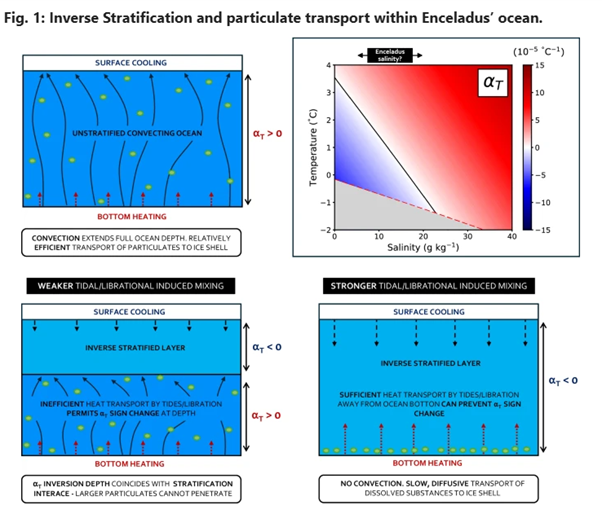The ocean inside Enceladus is likely to be strongly layered in a way that may prevent evidence of life from rising from its hoped-for locations to where we could detect it, new modeling suggests. If so, our prospects for confirming that Earth is not the only world in the Solar System with biology would fall dramatically, as would the chance of learning much about it if we could establish it was there. The problem is also likely to be more widespread.
ADVERTISEMENT GO AD FREE
Space agencies and billionaires are still mostly focused on Mars. However, if life exists beyond the Earth but within the Solar System, the odds now probably favor one of the many icy moons with an internal ocean.
If such life exists, it most likely thrives around hydrothermal vents where the ocean meets internal rock, an environment thought to be not unlike those that exist at the bottom of Earth’s oceans. Hopes for finding such life, however, rest on its products being circulated to the surface of these oceans and into space. This is where meteorologists and oceanographers have thrown a spanner in the works.
Although many internal oceans are now known or suspected, some of the greatest excitement in the last decade has focused on Saturn’s moon Enceladus, because geysers provide a highway from ocean to space. A future mission could sample the ocean, the argument goes, simply by flying through the geysers’ spray.
Unfortunately, researchers behind the new study point out that icy plumes represent tastings of the top of a very large body of water, not the whole thing. “Imagine trying to detect life at the depths of Earth’s oceans by only sampling water from the surface. That’s the challenge we face with Enceladus, except we’re also dealing with an ocean whose physics we do not fully understand,” lead author of the study Flynn Ames, of the University of Reading, said in a statement.
Ames and co-authors have attempted to work out whether giant currents would stir the ocean so that the upper layers can tell us about the most interesting bits.
ADVERTISEMENT GO AD FREE
“We’ve found that Enceladus’ ocean should behave like oil and water in a jar, with layers that resist vertical mixing,” Ames said. “These natural barriers could trap particles and chemical traces of life in the depths below for hundreds to hundreds of thousands of years. Previously, it was thought that these things could make their way efficiently to the ocean top within several months.” In that time, the authors fear, molecular evidence for life would break down.
The essential problem is that the ocean must cool as it approaches the border with the icy shell. Like most substances, water normally shrinks as it cools, becoming denser. However, at close to zero degrees, pure water starts to expand, preparatory to turning to ice, which floats because of its lower density. Brackish water does this too, Ames and colleagues note, if it has less than 20 grams of salt per kilogram.
“This means that cooling from above, rather than inducing convection, should act to increase water buoyancy and promote the development of a stratified layer underlaying the ice shell,” the authors write. When this happens in freshwater lakes on Earth it is called “inverse stratification”.

Three scenarios for Enceladus’s ocean: the traditional one where convection drives mixing (top left), with inverse stratification but different amounts of tidal forcing (bottom), and how temperature and salinity affect the coefficient of expansion, which could shape which is real (top right).
The team used a range of plausible figures for the salinity of Enceladus’s oceans and forces driving mixing, but it’s possible there’s something crucial about the moon we don’t know, and therefore is missing from the model. Complicating matters, the authors think the ocean is more stratified near the poles, where the geysers are, than at the equator.
ADVERTISEMENT GO AD FREE
If the conclusion is correct, however, the news is not just bad for the idea of a relatively cheap mission to the Saturnian system with equipment for chemical analysis on board. Other proposals for getting at these oceans involve snake-like robots that would slither through crevasses to sample the liquid water within. However, this would still only mean accessing what’s near the top. Few machines could survive the pressures near the vents themselves.
Inverse stratification could be a problem in other worlds where an icy shell protects a liquid ocean from the cold of space. However, other researchers have noted the effect is greater for smaller worlds with lower pressures, making Enceladus more vulnerable than Europa, or many other moons in this class.
These moons’ vents are tens of thousands of times closer than more Earth-like planets around other stars, but they may be almost as hard to reach.
The study is published open access in the journal Communications Earth And Environment.
Source Link: Humanity’s Best Chance of Sampling Extraterrestrial Life Could Be Thwarted By Physics